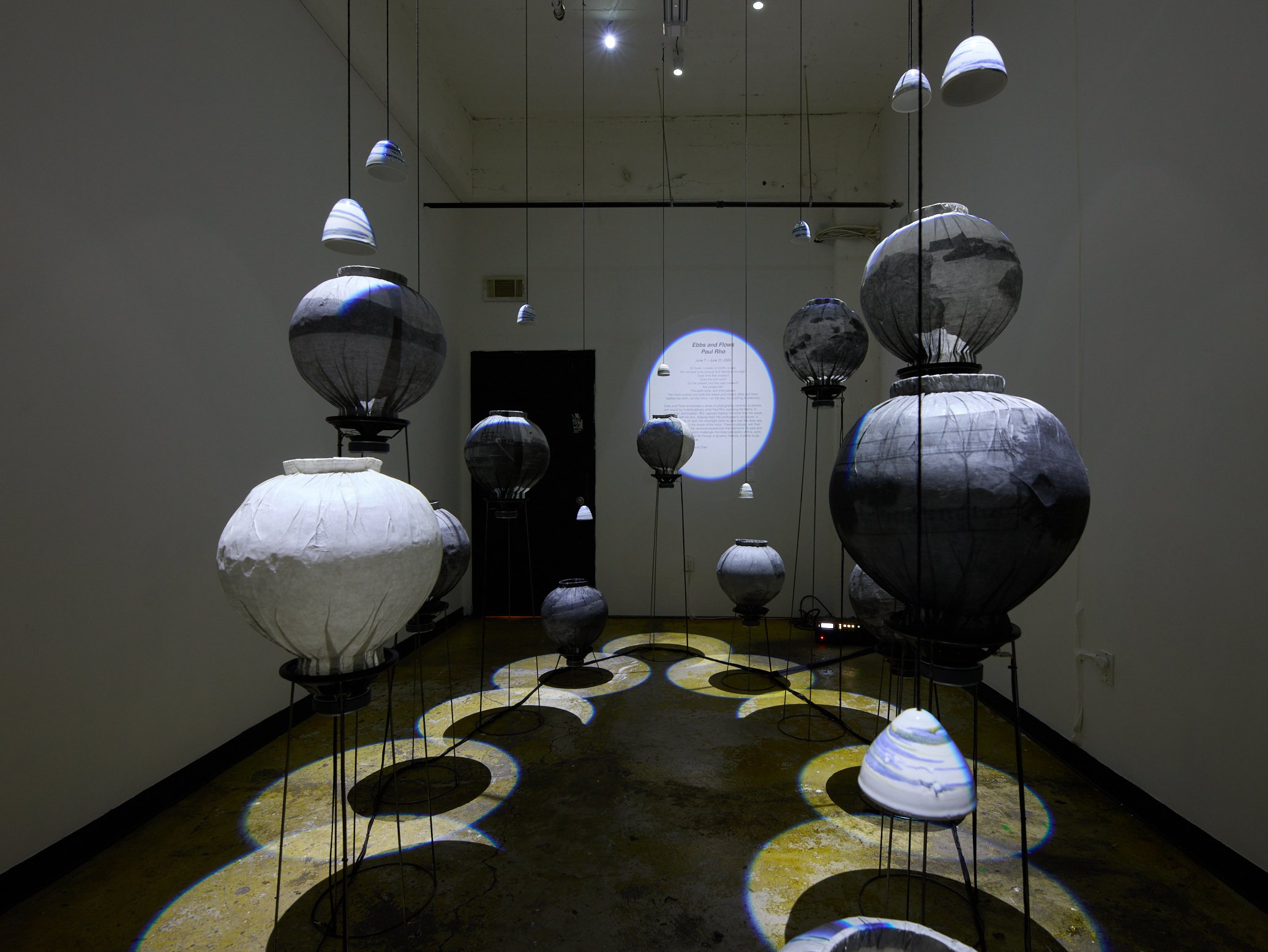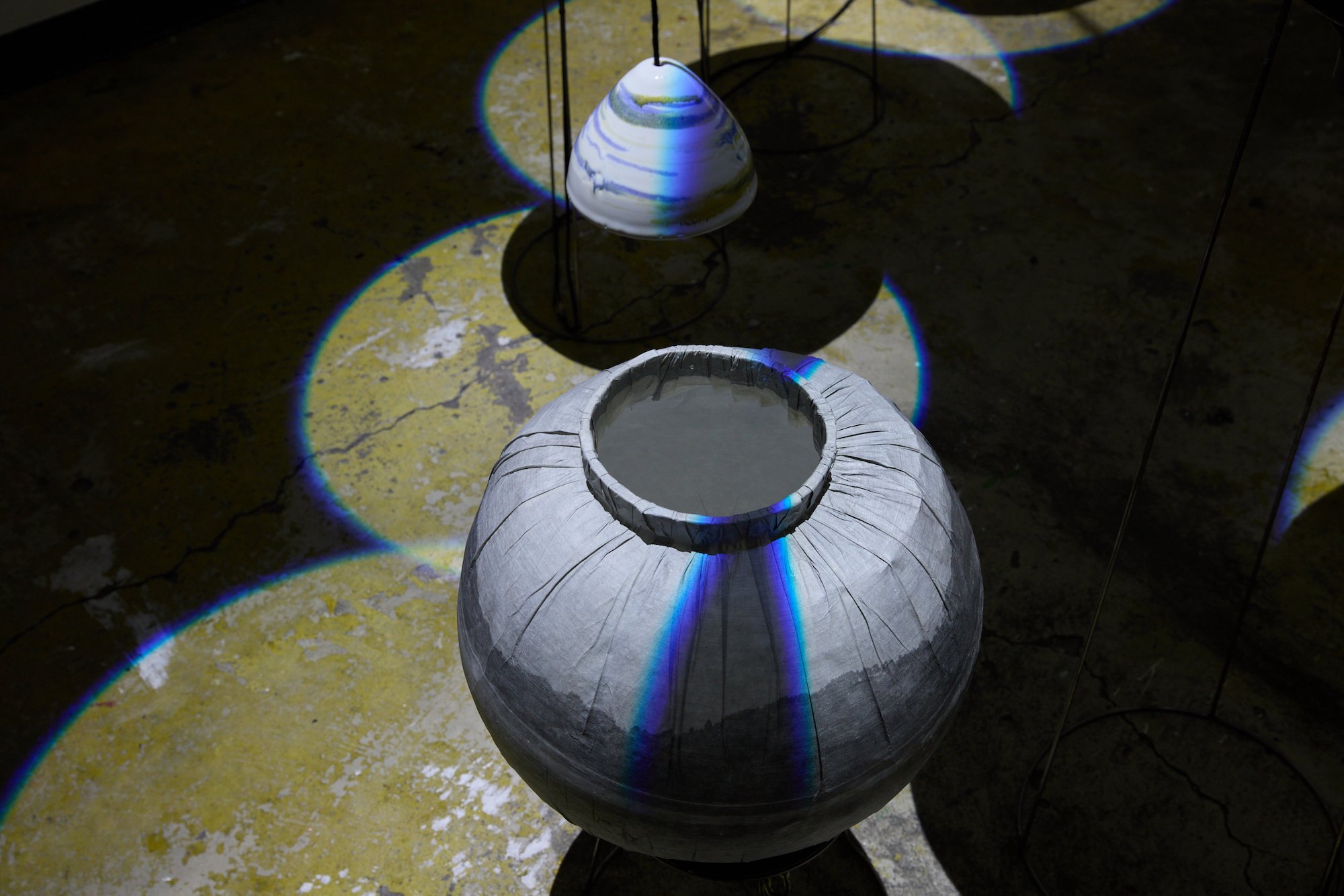A Letter Home with Paul Rho
Paul Rho was 13 when he ran away from his family home in South Korea, taking a late-night train to the coastal city of Busan. It was on the darkened train, washed away by the sweet silver sound of pitch-black waves, that he finally felt free and had his first taste of the undertow that would consume him in his artistic career. “There’re only hints of reflections, and you hear these waves. I felt such a liberation, getting away from my parent’s pressure and all those conflicts, and the dark sea really embraced me,” he said.
Rho would go on to call many places home, having lived in the U.K., U.S., Canada, Italy, and Argentina between his parents and various family members. Now, in his exhibition at Rockella, Ebbs and Flows, on view from July 7-21, 2024, Rho becomes reacquainted with the Korean soil he was once rooted in.
When you first step into the installation, you are greeted by soundscapes of crashing waves and the intermittent cooing of 12 ceramic bells designed by Rho, attached to jars styled after the traditional ceramic moon jars of the Joseon Dynasty. Prints of the Korean coastline on Mulberry Hanji paper are cast around each of the jars, grafting new skin onto ancient flesh. A traditional black ‘hanbok’ — translating simply as “Korean clothes” — looms large on the wall, hung in an embrace over the gallery, like a scarecrow keeping a watchful eye over the cool, quiet land.
Many of Rho’s friends commented on the hanbok’s crucifix-like positioning: having been raised Catholic, he is no stranger to the symbolism. And yet, he was less interested in the potential religious symbolism, focusing his eye on the consuming and embracing draw of the natural world in alignment with pre-Western Korean totemic practices. “I wanted to create this feeling of nothing scary — of something more embracing. The crucifix is such a symbol, but actually, Jesus was crucified in order to embrace anybody, and I felt somewhat that the dark ocean was embracing me, so it kind of symbolizes the ocean that I met,” he said.
Rho’s parents were strong followers of the Focolare, a lay organization of the Catholic Church, which led them to move to Argentina and Italy to be closer to the communities. This upbringing complicated his relationship to his Korean heritage — for a long time, he was hesitant to use his artistic practice as a means to explore his upbringing and was uninterested in the identity politics he saw others pursue in their craft during his undergraduate years.
Eventually, however, he found it impossible not to reckon with his own past — to him, Ebbs and Flows is the tipping point in which he finally tackles the topic of belonging and roots head-on. “In the end, it feels like it’s a task that you actually have to pass to resolve the questions, like who you are really as a person, rather than an artist. It really helped me to stitch up all these missing puzzles,” he said.
He attributes his mixed-media style to his complicated upbringing — though he began as a traditional photographer, Rho began to feel that only so much could be extracted from a simple photo, methodically developed, framed, and hung neatly on the wall. “I was tired of repeating the routine of taking photos, developing, printing, and then mounting on a wall. It just felt like there’s a cycle, and I wanted to break that and have much more involvement with my physical body,” he said. He began to experiment with sewing and painting on photos before discovering his love of the highly physical ceramic process and combining the two for the exhibition.
His interest in moon jars in particular began when he started his ceramic practice — the history of the jars is shrouded in mystery, with no written record of those who made them or why they did it. “I was not so keen on my own culture, my Korean heritage,” he said. “When I started taking classes, I started questioning myself more into how much I know about my own culture.” These hazy notions of the moon and its mystical place in traditional Korean spirituality clung to him, leading him back to his homeland just as the lunar pulls lead the undulating waves.
For Rho, the ocean is a temple — Ebbs and Flows, then, is a spiritual space that oozes with a quality of surrender. He finds a way to give himself completely to a higher power, to let the dark waves that transfixed him as a boy sweep him under once more.
You Might Also Like:
Migration in Dialogue – Po Yu Chen and Yue Jiang




